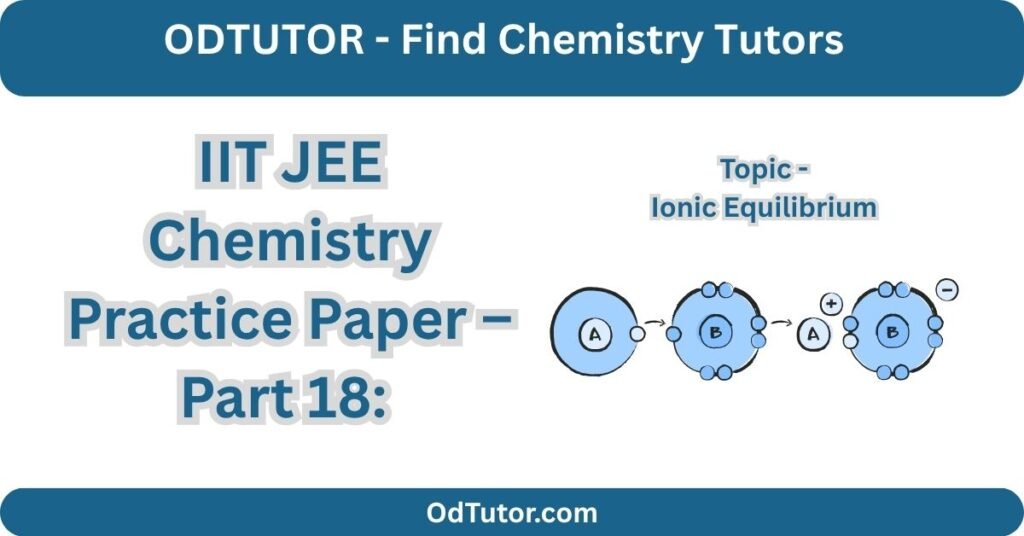Topic: Ionic Equilibrium
Type: Multiple Choice Questions (MCQs)
Marks: +4 for each correct answer
Negative Marking: 0 (Practice Mode)
Ionic Equilibrium: The Dance of Ions in Solution
A Strategic Guide for IIT-JEE Aspirants by Prof. Anil Tyagi
Future engineers, welcome. While chemical equilibrium deals with molecules, Ionic Equilibrium unveils the dynamic world of ions in solution—a realm critical for understanding everything from blood chemistry to industrial processes. This topic is a cornerstone of physical chemistry for JEE, demanding both conceptual clarity and numerical agility. Our goal is to master the behavior of acids, bases, and salts when they dissociate in water.
1. The Foundation: Electrolytes & Degree of Dissociation
- Electrolytes: Substances that dissociate into ions in aqueous solution, conducting electricity.
- Strong Electrolytes: Completely dissociate (e.g., HCl, NaOH, NaCl, KNO₃). They are treated as having a degree of dissociation (α) = 1.
- Weak Electrolytes: Partially dissociate, establishing an equilibrium (e.g., CH₃COOH, NH₄OH, HCN). Here, 0 < α < 1.
- Ostwald’s Dilution Law: Quantifies the relationship between the degree of dissociation (α) and the concentration (C) for a weak electrolyte.
> For a weak acid: Kₐ = Cα² / (1-α) ≈ Cα² (if α is very small)
This shows that for weak electrolytes, the degree of dissociation increases with dilution.
2. Acid-Base Theories: The Evolving Definition
- Arrhenius Concept (Limited): Acid produces H⁺, Base produces OH⁻.
- Brønsted-Lowry Theory (Crucial for JEE):
- Acid: Proton (H⁺) donor.
- Base: Proton (H⁺) acceptor.
- Conjugate Acid-Base Pairs: Differ by a single proton. A strong acid has a weak conjugate base, and vice-versa.
- Lewis Concept (Broadest): Acid is an electron-pair acceptor, Base is an electron-pair donor.
3. The Core of Quantitative Analysis: pH and pOH
The power of these concepts lies in their logarithmic scale, which converts cumbersome numbers into manageable values.
- Definitions:
- pH = -log₁₀ [H⁺]
- pOH = -log₁₀ [OH⁻]
- pKₐ = -log₁₀ Kₐ
- pKբ = -log₁₀ Kբ
- The Fundamental Relation: At 298 K (25°C),
> pH + pOH = 14 (Derived from K_w = [H⁺][OH⁻] = 10⁻¹⁴)
4. Calculating pH for Different Scenarios
This is a high-frequency question in JEE. You must be able to identify the system and apply the correct formula.
- Strong Acid (e.g., HCl):
[H⁺] = C;pH = -log C - Strong Base (e.g., NaOH):
[OH⁻] = C;pOH = -log C;pH = 14 - pOH - Weak Acid (e.g., CH₃COOH): Uses the equilibrium constant Kₐ.
> [H⁺] = √(Kₐ * C) ;pH = ½ pKₐ - ½ log C - Weak Base (e.g., NH₄OH): Uses the equilibrium constant Kբ.
> [OH⁻] = √(Kբ * C) ;pOH = ½ pKբ - ½ log C - Salt Solutions (Hydrolysis):
- Salt of Weak Acid & Strong Base (e.g., CH₃COONa): Basic solution.
> [OH⁻] = √( (K_w / Kₐ) * C ) ;pH = 7 + ½ pKₐ + ½ log C - Salt of Strong Acid & Weak Base (e.g., NH₄Cl): Acidic solution.
> [H⁺] = √( (K_w / Kբ) * C ) ;pH = 7 - ½ pKբ - ½ log C
- Salt of Weak Acid & Strong Base (e.g., CH₃COONa): Basic solution.
5. The Guardians of pH: Buffer Solutions
A buffer solution resists a change in pH upon the addition of small amounts of acid or base. They are indispensable in biological systems.
- Types and Composition:
- Acidic Buffer: A weak acid + its salt with a strong base (e.g., CH₃COOH + CH₃COONa).
- Basic Buffer: A weak base + its salt with a strong acid (e.g., NH₄OH + NH₄Cl).
- The Henderson-Hasselbalch Equation (Master this!):
- For an Acidic Buffer: pH = pKₐ + log₁₀ ( [Salt] / [Acid] )
- For a Basic Buffer: pOH = pKբ + log₁₀ ( [Salt] / [Base] )
- Buffer Capacity: Maximum amount of acid/base a buffer can neutralize before significant pH change. It is maximum when
[Salt] = [Acid/Base], i.e., whenpH = pKₐ.
6. The Solubility Equilibrium: When Precipitates Form
This tells us whether a salt will dissolve or precipitate under given conditions.
- Solubility Product (K_sp): For a salt AₓBᵧ ⇌ x Aᵃ⁺ + y Bᵇ⁻
> K_sp = [Aᵃ⁺]ˣ [Bᵇ⁻]ʸ - Ionic Product (I.P.): The product of the ionic concentrations at any given moment, not necessarily at equilibrium.
- The Precipitation Criteria:
- If I.P. < K_sp: The solution is unsaturated. No precipitate forms. More salt can dissolve.
- If I.P. = K_sp: The solution is saturated. The system is at equilibrium.
- If I.P. > K_sp: The solution is supersaturated. Precipitation occurs until I.P. = K_sp.
Key Relationship: For a 1:1 electrolyte like AgCl, Solubility (S) = √K_sp. The relationship becomes more complex for other stoichiometries (e.g., for A₂B₃, K_sp = 108 S⁵).
Professor Tyagi’s Key Takeaways for JEE Success:
- Identify the System: The first step in any pH problem is to correctly identify if you are dealing with a strong/weak acid/base, a salt, or a buffer.
- Henderson-Hasselbalch is Your Best Friend: This single equation is powerful for buffer problems and acid-base titration curves (especially the half-equivalence point, where pH = pKₐ).
- The Common Ion Effect: The dissociation of a weak electrolyte is suppressed by adding a strong electrolyte having a common ion. This is the principle behind buffer action. Use it to solve related problems.
- Link K_sp to Solubility: Practice deriving the relationship between K_sp and solubility (S) for different salt types like MA, M₂A, MA₂, M₂A₃, etc. This is a guaranteed marks-scoring area.
Master these principles. Ionic Equilibrium is not about memorization; it’s about applying a logical framework to predict the behavior of ions in solution.
Your clarity of concept here will be the common ion that precipitates your success in JEE.
– Prof. Anil Tyagi

